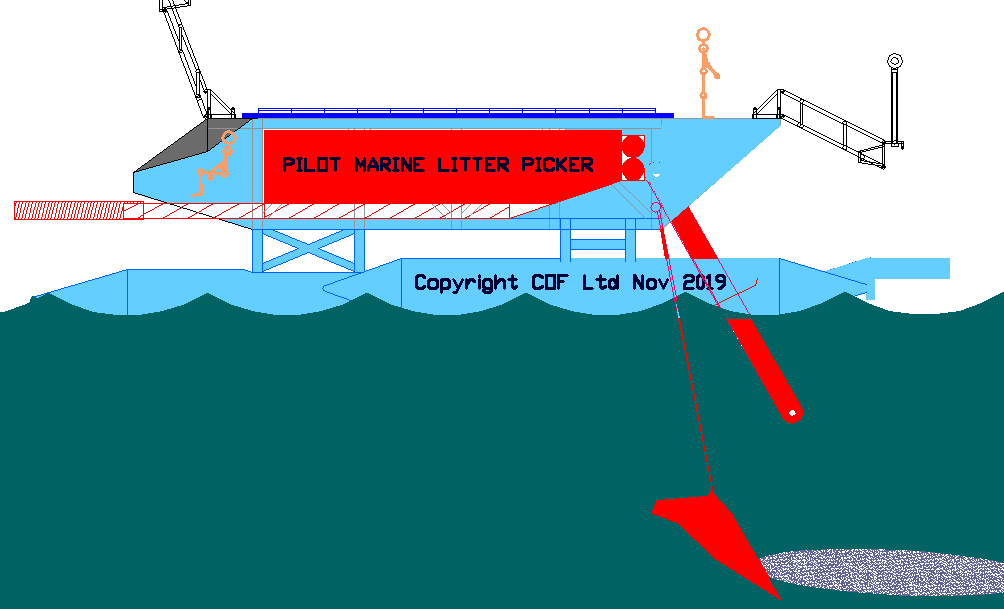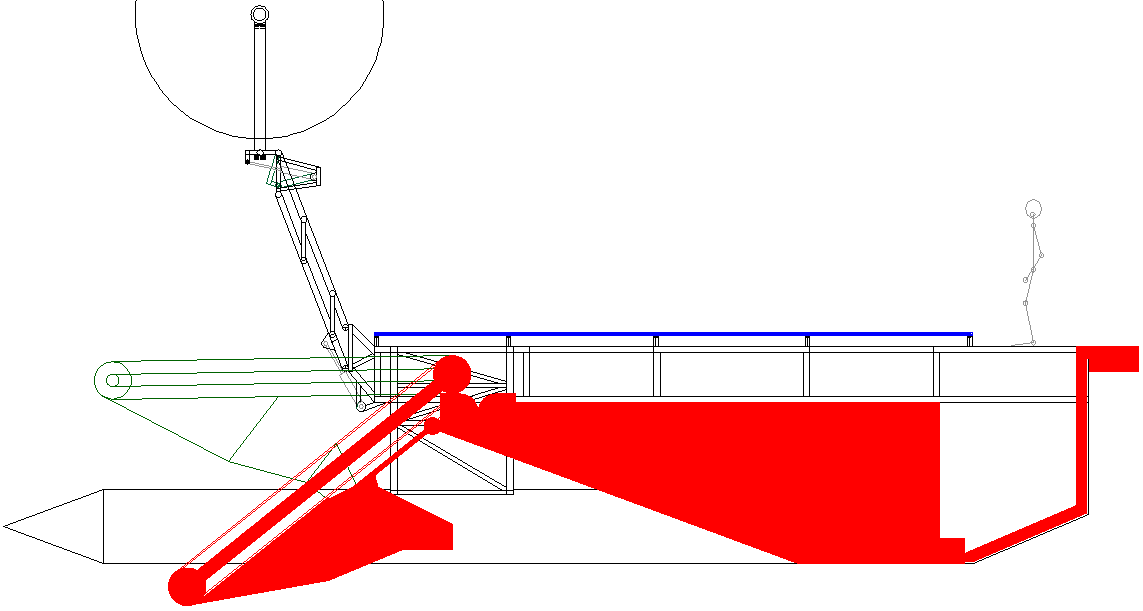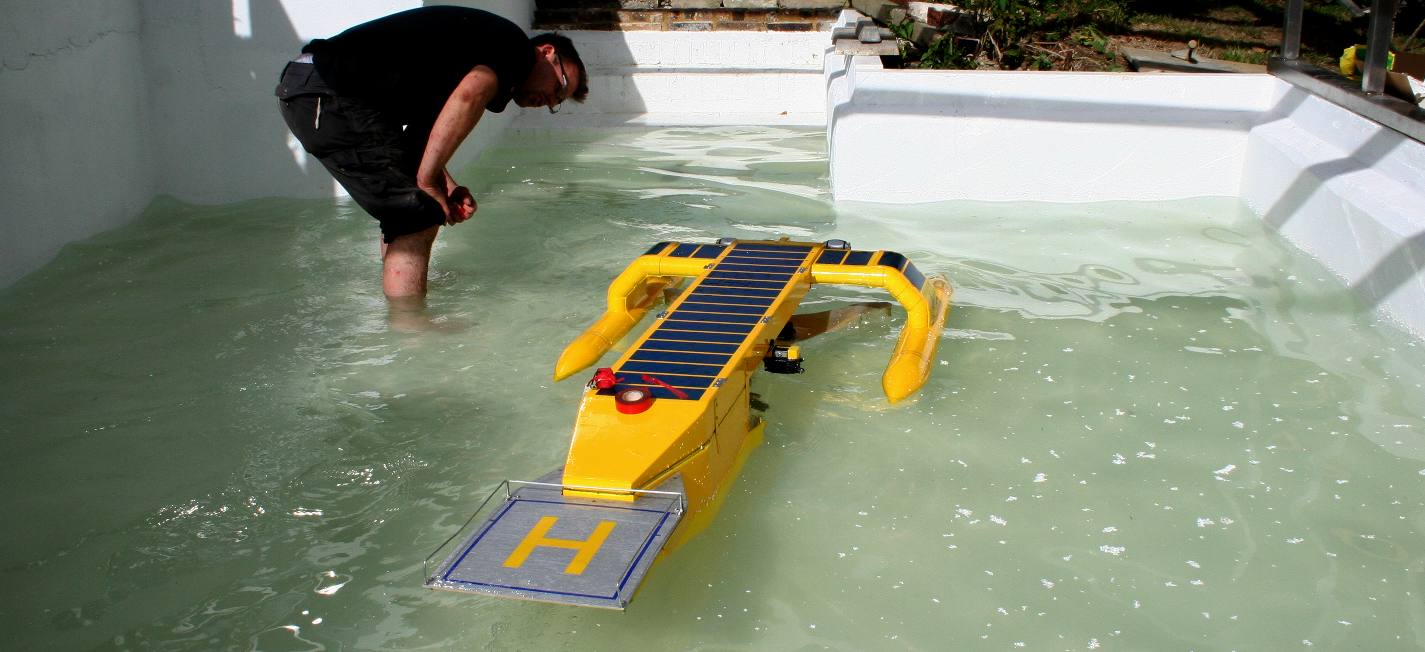|
SEA & RIVER VAX PATENT
Please use our A-Z INDEX to navigate this site, where page links may lead to other sites
|
||||
|
Combined plastic discharge coupling and survey drone landing pad. |
|
150 ton holding tank for collected ocean or river waste.
|
|
|
|
|
5083 alloy hull for corrosion free service life. |
|||
|
|
|
|||
|
Large 220 m2 area of photovoltaic panels as arrays that track the sun autonomously. |
Up to 20kW wind turbines boom mounted to track wind autonomously. |
|||
|
|
|
|||
|
Trimaran hull configuration for stability at sea. |
Modular construction to simplify production. |
|||
|
|
|
|||
|
|
|
Large 2-stage 13.5 meter filter-collector head to vacuum up plastic particles - with adjustable operating height and safety features to protect marine life. |
||
|
2020 - The heart of the SeaVax concept is a comprehensive filtration system that is capable of recovering plastics from the open ocean in sufficient quantities to make recycling the waste worthwhile. The system selectively prevents the ingress of delicate fauna, while scooping up marine debris from 0.5mm just below the surface - to large floating objects. The filtration system is powered by wind and solar energy.
PATENT
A patent application is presently being drafted. This relates to the SeaVax concept as may be applied to river cleaning and blue water filtration.
We may not fully describe the system here where a patent specification is to be filed internationally within 12 months of a UK filing.
This precaution is necessary where at this time the Foundation is ineligible for grant funding according to extant policies that pay no heed to urgency. A transition to a more commercial footing could become an option (or even forced on the Foundation) as and when the G20 and other organizations clarify their position as to responsibility for trash recycling in their geographical regions. The Foundation is in communication internationally on this subject.
By filing a patent the Foundation aims to preserve the status quo should the project need to be passed to another type of entity that may achieve funding, perhaps via business angels, who may need IP rights for the security of their investors. Should the patent not be needed as venture capital security, free licenses will be issued for social enterprise.
DEEP CLEAN - In this diagram we see a 16 meter Pilot version of SeaVax with the selective filtration cleaning head lowered to a depth of 8 meters to deal with deeper micro plastics. Surface plastic may still be collected with the conveyor system that is similar in concept to Mr Trash. By this means larger volumes of litter may be processed. Copyright © diagrams 25 November 2019. All rights reserved, Cleaner Ocean Foundation Ltd.
HOW DO WE DO IT
The question we are most often asked, is how is it possible to filter plastic particles from seawater without harming marine life?
The problem has baffled scientists for years. With debunkers more than happy to take pot shots at the concept without understanding how it is achieved.
Problems like this are solved by an inventive step that a naysayer would not cotton to, or they would be inventors. It is easy to sit on the sidelines and criticize - though some debunking is helpful in that it gets people thinking on a problem where it was previously thought to be impossible to resolve.
Invention only happens once for any problem, otherwise it is no longer inventive. This means that the solution is not obvious. Hence the term "Invention."
To obtain a patent there has to be an inventive step, rather than a logical application of existing technology.
Patent law prohibits publication before grant - meaning that you'll have to stay in the dark for a little longer. Unless, you come up with a similar solution yourself. By way of example, the light bulb was invented simultaneously on both sides of the Atlantic, by Edward Swan in the UK, who predated Thomas Edison in the USA.
You'll not upset us if you choose to develop a competitor system. The ocean needs all the help it can get. Indeed, our volunteers look forward to the day they might retire. If they can retire earlier, so much the better.
PATENT PENDING - The filtration module, cargo hold and offloading mechanism is shown in red in outline form. The system consists of several integrated components, incorporating motors, pumps, hydraulics, electronics and computer programs - all to be powered by energy from nature - if we are to avoid more greenhouse gas emissions. Note that this is the design for the 12 meter coastal development rig, rather than the 45 meter full size craft. Copyright © diagram Cleaner Ocean Foundation. All rights reserved.
MULTIPLE STAGES: ENTRY
SeaVax uses three physical stages of filtration and a whole bunch of sensors and controls to remove plastic and a number of non-physical deterrents. Each stage is designed to enhance collection and filtration of the next stage, to avoid wasting energy and increase a useful plastic harvest, while at the same time protecting marine flora and fauna.
In practice the first two physical stages are relatively simple. Relatively. The third stage is where the really clever stuff is:
1. The first stage in much like other skimmers, where single use bottles, bags are crushed and compressed, and other larger plastic flotsam, including fishing nets and rope, is fed into a hopper and modified, then fed into a giant holding tanks, until the waste can be offloaded to a converted cargo ship while at sea (when fully developed), or landed at a dockside. Waste has to be graded according to value for recycling. We want to get as much value out of the catch as possible.
2. The second stage is slightly more complicated where a mesh is variable in size and may be increased or decreased in (effective) net size to deal with what is ahead of the craft, to ensure that smaller marine life (zooplankton, shrimps, krill) does not pass through to the final stages and clog up the works. Zooplankton, Shrimp and krill are directed back into the sea while inorganic waste is collected and once again fed into a holding tank. We need to keep delicate fauna away from the final stage selective filters.
3. The third (final) stage is where we need to be smarter, involving advanced robotics and programming, akin to object recognition, allied to arrays of sensors that generate digital limits to ensure that only plastic is collected - while marine biota is safeguarded. There is no mesh or net at this stage, simply spinning water and variable taps as an advance to conventional hydrocyclonic chambers. But even then there is more. Without automation, we would not be able to select the right filters* at the right time.
Patents can take up to four years to grant. In the UK green inventions may be accelerated. The Foundation is not making the patent applications, rather a benefactor is doing this, supporting a professional inventor with a 100% track record of converting applications to grants. The Foundation cannot afford to make patent applications, nor employ patent attorneys.
* A filter is any means to select one thing over another, rather than conventional physical filters.
No system can be 100% effective. For that reason SeaVax may shut down in extraordinary conditions, until fishing for plastic may safely resume.
MATERIALS HANDLING: EXIT
As with collection, there are multiple stages for handling the collected plastic waste, such as to maximize returns for investors. These are not described here. Any organization interested in supporting SeaVax development may learn more subject to completion of a Non-Disclosure (Confidentiality) Agreement.
MACHINE WITH A PURPOSE
Many people have helpfully suggested adding our filtration system to the bow of existing vessels as an accessory - and this is a logical thought progression - that we passed through. Plainly, such suggestion would be difficult to implement and the hydrodynamics of the host vessel would be in conflict with the need for efficient transit of cargo or fishing vessels.
As you may note from the design of the collector head, SeaVax is the filtration system: the whole of the vehicle is purpose designed to sort and recover plastic waste, then store it for transfer to another vessel, or a dockside for recycling. The system will not transpose easily to another vessel that is not purpose designed and will suffer transfer and sorting difficulties. It is more cost effective to build fresh than to try and convert existing vessels that are less than ideal.
OCEAN CLEANING MACHINES - This is what SeaVax looked like in 2016 when BMS floated a 1:20 model in a water basin loaded with floating plastic waste. A few minutes after the system was switched on, we had all but cleared the tank of floating debris. This was an impromptu test following the first tank fill up. Chris immediately decided to put the SeaVax in the water and give it a whirl. BMS was very pleased with the results. From this point on tests will be more scientific and full size. Though the concept model may still play a part in trials. Please note that SeaVax is Design Copyright © as are the diagrams, even where no specific details are provided, the basic design is protected.
OCEAN CLEANUP PROJECTS
* Adidas * Algalita research foundation * Aliance to end Plastic Waste * Boyan Slat's ocean booms * 4Ocean recycled plastic bracelets * Earth Day ocean plastic fact sheet * Fionn Ferreira's ferrofluid extraction of microplastics * Junk Raft - plastic expedition * Plastic Oceans Canada * Plastic Oceans Org * Seabin * SeaVax autonomous drones * Surrey University PIRATE & Triton
|
||||
|
ABS - BIOMAGNIFICATION - CANCER - CARRIER BAGS - COTTON BUDS - DDT - FISHING NETS HEAVY METALS - MARINE LITTER - MICROBEADS - MICRO PLASTICS - NYLON - OCEAN GYRES - OCEAN WASTE PACKAGING - PCBS - PET - PLASTIC - PLASTICS - POLYCARBONATE - POLYSTYRENE - POLYPROPYLENE - POLYTHENE - POPS PVC - SHOES - SINGLE USE - SOUP - STRAWS - WATER
Please use our A-Z INDEX to navigate this site, where page links may lead to other sites
|
||||
|
This website is provided on a free basis as a public information service. copyright © Cleaner Oceans Foundation Ltd (COFL) (Company No: 4674774) 2019. Solar Studios, BN271RF, United Kingdom. COFL is a company without share capital.
|
||||


